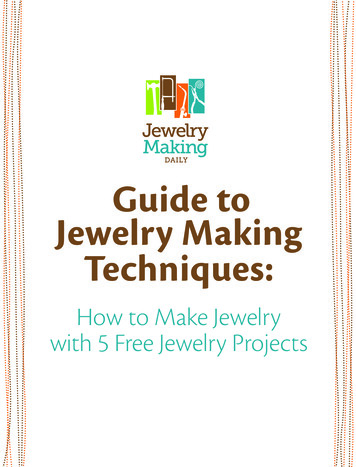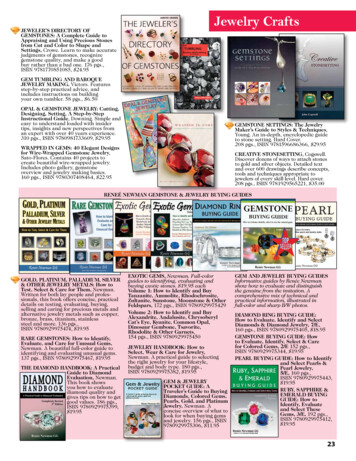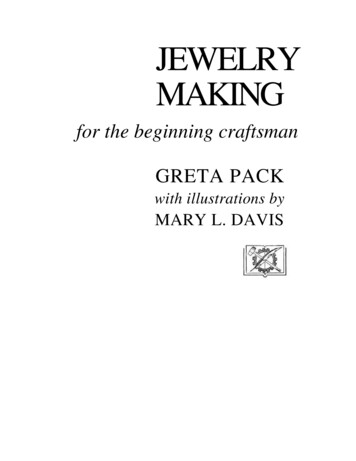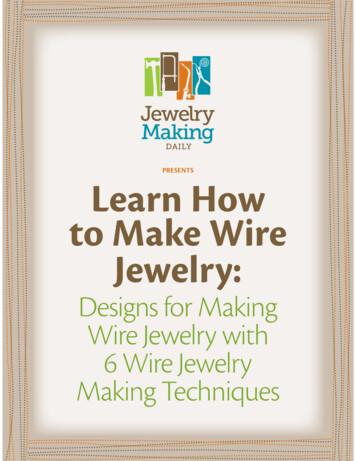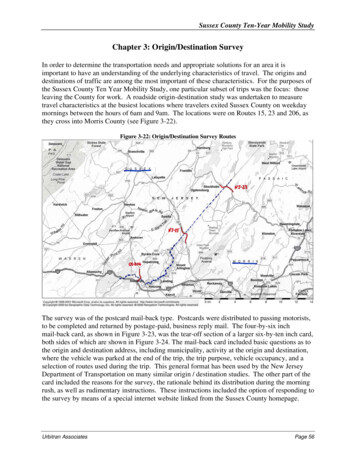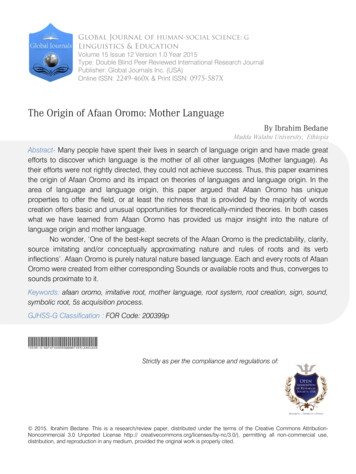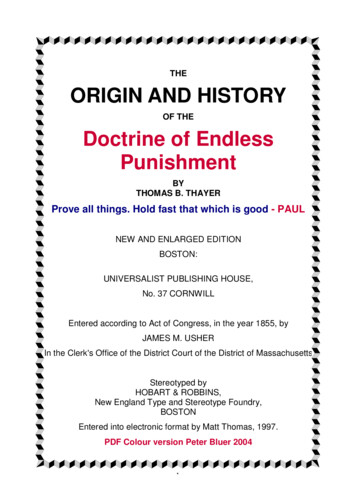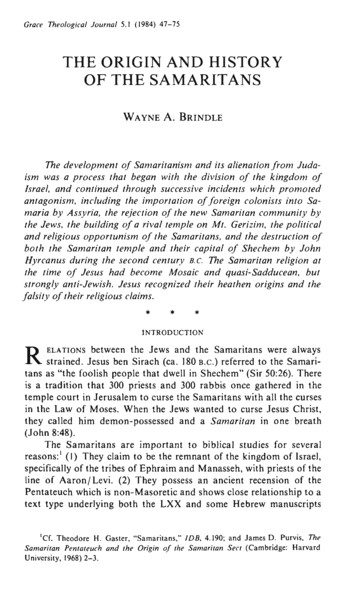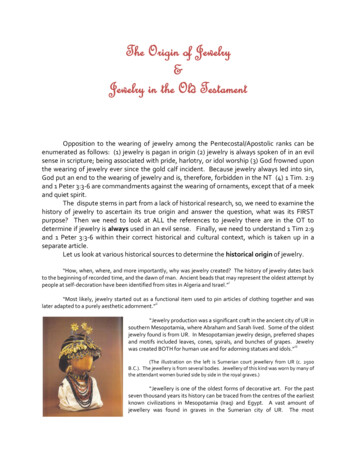
Transcription
The Origin of Jewelry&Jewelry in the Old TestamentOpposition to the wearing of jewelry among the Pentecostal/Apostolic ranks can beenumerated as follows: (1) jewelry is pagan in origin (2) jewelry is always spoken of in an evilsense in scripture; being associated with pride, harlotry, or idol worship (3) God frowned uponthe wearing of jewelry ever since the gold calf incident. Because jewelry always led into sin,God put an end to the wearing of jewelry and is, therefore, forbidden in the NT (4) 1 Tim. 2:9and 1 Peter 3:3-6 are commandments against the wearing of ornaments, except that of a meekand quiet spirit.The dispute stems in part from a lack of historical research, so, we need to examine thehistory of jewelry to ascertain its true origin and answer the question, what was its FIRSTpurpose? Then we need to look at ALL the references to jewelry there are in the OT todetermine if jewelry is always used in an evil sense. Finally, we need to understand 1 Tim 2:9and 1 Peter 3:3-6 within their correct historical and cultural context, which is taken up in aseparate article.Let us look at various historical sources to determine the historical origin of jewelry.“How, when, where, and more importantly, why was jewelry created? The history of jewelry dates backto the beginning of recorded time, and the dawn of man. Ancient beads that may represent the oldest attempt byipeople at self-decoration have been identified from sites in Algeria and Israel.”“Most likely, jewelry started out as a functional item used to pin articles of clothing together and wasiilater adapted to a purely aesthetic adornment.”“Jewelry production was a significant craft in the ancient city of UR insouthern Mesopotamia, where Abraham and Sarah lived. Some of the oldestjewelry found is from UR. In Mesopotamian jewelry design, preferred shapesand motifs included leaves, cones, spirals, and bunches of grapes. Jewelryiiiwas created BOTH for human use and for adorning statues and idols.”(The illustration on the left is Sumerian court jewellery from UR (c. 2500B.C.). The jewellery is from several bodies. Jewellery of this kind was worn by many ofthe attendant women buried side by side in the royal graves.)“Jewellery is one of the oldest forms of decorative art. For the pastseven thousand years its history can be traced from the centres of the earliestknown civilizations in Mesopotamia (Iraq) and Egypt. A vast amount ofjewellery was found in graves in the Sumerian city of UR. The most
impressive discoveries were made in some tombs dated about 2500 B.C., usually regarded as royal graves.No date can be put on the first use of jewellery to proclaim the wearer’s wealth and social status. Atsome very early stage in man’s history relatively scare materials began to be selected and fashioned for thispurpose. Wealth and rank seem to have been critical to the use of jewellery as personal ornament and, perhaps,as currency in social transactions, such as gift-giving and bride-wealth. This economic function of jewellery wasparticularly important before the invention of coinage.Probably the most ancient purpose of the finger-ring was simply to be decorative, as the finger-ringsfrom the graves at UR (c.2500 B.C.) would seem to indicate. In Rome the practice of wearing finger-rings forrdsealing purposes is well documented, and by the end of the 3 century BC, Roman consuls were wearing signetivrings with a distinctive device.”“In ancient Egypt both men and women wore jewelry; not only as a symbol of wealth and status, but alsofor aesthetic adornment, and as protection from evil. The ancient Egyptians placed great importance on thevreligious significance of certain objects, which was heavily reflected in their jewelry motifs.”“The love of adornment has been expressed in the wearing of precious stones and the making of jewelrysince the beginning of history.The Israelites probably learned to make jewelry from those under whose dominance and influence theycame. The first such people were the Egyptians. The workmanship associated with the tabernacle, esp the highpriest’s breastplate, was probably Egyptian in style and character. At a later period the Israelites came underPhoenician and then finally Chaldean influence.Besides the jewels employed in ceremonial worship, the Israelites wore a variety of types of jewelry ineveryday life. Many men for business reasons wore a signet seal or ring which served as the person signature ofits owner (Gen. 38:18; Song of Solomon 8:6).The women decorated themselves more elaborately and wore several types of ornaments. Earrings wereviuniversally worn by women.”“A museum in Israel will open an exhibition of rare and ancient jewelry excavated in archaeological sitesthroughout Israel. The exhibition will reveal gold jewelry that has never before been seen, much of which datesfrom Biblical times and earlier. The jewels, some of which are set with precious stones, enable a rare glimpse intothe lifestyle and culture of the ancient Israelites.The exhibition also reveals a great deal about the creation of ancient jewelry—the methods, thecraftsmen, and influences of other ancient civilizations, and the role jewelry played in the religion and culture ofthe times. More than 100 pieces were chosen to shed light on the subject.The exhibition brings back the days of the Bible, when golden balls used in intricate jewelry designswere known as “apples.” The exhibition takes its name from the Book of Proverbs chapter 24, verse 11: “A wordfitly spoken is like apples of gold in pictures of silver.”The managing director said, “Our ancient roots include a rich jewelry-making tradition. The exhibition isviia unique opportunity to explore this tradition, which forms the basis for our contemporary jewelry creations.”“In primitive cultures jewelry was used for pagan rituals, to honor a particular deity, or as an offering inviiisacrificial ceremonies; though SOMETIMES, jewelry was used for nothing more than simple beautification.”“The Hebrew word nezem signifies a ring and is used both of nose ring and earring. The gold ring in itselfwas neither good nor bad, but could be used in idolatrous worship (the golden calf), or given to the Lord, or wornas an object of beauty.The word lahash means an amulet or charm. It is translated as “earring” in Isaiah 3:20. The root meansix“to whisper” or “to conjure,” “to mumble a spell (as a magician)” and thus refers to charms of metal or jewelswhich were thought to have protective powers. Sometimes they were inscribed with magical formulas or werexshaped like god-emblems, as among the Egyptians. Images of gods or teraphim were also common amulets.
According to history: (1) The FIRST use of jewelry was NOT in association with idolworship, but rather, it served a functional purpose and later as personal adornment (2) TheORIGIN of jewelry is not idolatry, but sometimes jewelry was used in association withidolatry—not always. Sometimes pagan jewelry bore religious symbolism in their motifs. (3)The Hebrew people, as part of their culture, wore jewelry and manufactured jewelry.Talismanic or Amuletic JewelrySometimes jewelry AND clothing was wornin worship of idols, but talismanic or amuleticjewelry was manufactured with idolatrouscharacteristics. So much Egyptian jewellery had amagical significance that is impossible todistinguish the purely amuletic from theornamental.xi To protect themselves from hiddenmalevolent forces, such as poisonous snakes,scorpions, disease, floods or almost any naturaldisaster, illness, or tangible foe, ancient Egyptianswore amulets, or charms. In order to give anamulet its power, it had to be made and dedicated in strict accordance with the instructionswritten in the Book of the Dead. Only then, would the appropriate god’s spirit live within andenergize the amulet. This now sacred object would have to be treated with respect in order forthe god to continue bestowing his blessings upon the wearer.xii By the later stages of the NewKingdom there is a marked increase in the use of amulets and figures of deities as decorativeelements in jewellery.Probably the most ancient purpose of the finger-ring was simply to be decorative, asthe finger-rings from the graves at Ur (c. 2500 BC) would seem to indicate. The rings above arePhoenician (c. 6th cen. B.C.) and represent jewelry of an idolatrous character. The Phoenicianstyle is characterized by the use of motifs derived from Egypt.xiii The cornelian scarab showsIsis suckling Horus, with Osiride figures on either side and a winged disc above. This signet wasprobably not worn on a finger but attached to a sting or necklace. The green glass scaraboid(on left) represents two winged sphinxes on either side of a sacred tree. This ring could beworn on the finger, with the design against the skin, of so desired, to prevent it from becomingdamaged.xivThe Hebrew language differentiates between “earrings” of an idolatrous character[lachash] from those worn for beauty [nezem; agiyl]. The earrings found in Jacob’s household(Gen. 35:1-4); those worn by the Ishmaelite men and taken in the spoils in Judges 8:24-26; andIsaiah 3:16-26 were amuletic—involved in the worship of idols. The UPCI claims theIshmaelites and Midianites were distinguished from Israelites by their use of earrings and otherjewelry,xv but Israelite MEN did not wear earrings, whereas Ishmaelite MEN did. Amulets andother objects common to the magical arts have been found in Palestinian excavations. Magicwas practiced in Babylon and also by the Canaanites.xvi
Rebekah’s Jewelry“ the man took a golden earring of half a shekel weight, and two bracelets for her hands of ten shekelsweight of gold; (26) And the man bowed down his head, and worshipped the LORD. (47) and I put the earring uponher face, and the bracelets upon her hands. (48) And I bowed down my head, and worshipped the LORD (53) Andthe servant brought forth jewels of silver, and jewels of gold, and raiment, and gave them to Rebekah: and he gavealso to her brother and to her mother precious things.”The account of the betrothal and marriage of Rebekah to Isaac is the first instance wehave of jewelry in the Bible. The description gives a fair picture of marriage practices amongthe early Hebrew people. The two types of gifts mentioned both related to marriage customsof the times: the bride price [mattan] given by the family of the groom to the bride’s family;in Rebekah’s case, it is gold and silver jewelry and clothing, with additional gifts for membersof her family; and the dowry [mohar] which was money, servants/slaves and gifts taken withthe bride to her new home; Rebekah took her nurse and maids with her as part of her dowry.xviiShekhem, desiring to marry Dinah, Jacob’s daughter (Gen. 34:12) says, “Ask me neverso much DOWRY [mohar] and GIFT [mattan], and I will give according as ye shall say unto me:but give me the damsel to wife.” THROUGHOUT JEWISH HISTORY the mohar institution wasnever abolished.xviiiBiblically, jewelry was not pagan in its origin. God blessed Abraham and made himwealthy in silver and gold (v35), so Rebekah’s gold jewelry came from GOD! Moreover,Abraham did not worship idols! (Gen. 26:4, 5 “Abraham obeyed my voice, and kept my charge,my commandments, my statutes, and my laws.” James 2:23 “ Abraham believed God, and itwas imputed unto him for righteousness; and he was called the Friend of God.”) Notice afterputting jewelry upon Rebekah, what did the servant do? HE WORSHIPED GOD! Had jewelrybeen “idolatrous”, “worldly”, or “sinful”, then Abraham’s servant would have been a hypocrite.Would Abraham send his servant with jewelry to adorn his future daughter-in-law andnot adorn his own wife? SARAH ALSO WORE JEWELRY!JudahThe first instance of a man wearing jewelry in the Bible is Judah, Jacob’s son, in Gen.38:18. “ Thy signet, and thy bracelets, and thy staff that is in thine hand ” Often the top of aman’s staff was ornamented.xix All these objects were normal and obviously worn without thesense of their being sinful.JosephIn Gen. 41:41-42 Joseph wears the Egyptian Pharaoh’s ring. “And Pharaoh took off hisring from his hand, and put it upon Joseph’s hand, and arrayed him in vestures of fine linen, andput a gold chain about his neck ” Even though the Pharaoh worshiped idols, Joseph did not
regard the jewelry as “idolatrous” and turn down the gifts of jewelry, given to him by thePharaoh, which symbolized power and authority and went along with the vestures of finelinen. Necklaces were worn by men of rank and rulers of foreign nations.xxThe Israelites Spoil the EgyptiansIn Exodus 3:21-22; 11:2; 12:35-36 the Israelites are instructed by God to “spoil” theEgyptians upon their exit and were told by God to put the “spoils”—clothing and jewelry—ontheir sons and their daughters. It is a common teaching among the Pentecostals that thejewelry (forget about the raiment) was meant for later use in the Tabernacle and not forpersonal adornment, but God was not secretive in His instructions to Moses. There is noindication that God had a hidden motive, but plainly the reason for the jewelry was that ofadornment.Much of the gold that was given for the Tabernacle had been taken from theEgyptians. These articles supplied sufficient material for making the sacred utensils.xxi But,this was in the form of a “freewill” offering and included much more than their gold. (Ex. 35:429; Num. 31:50). It was not because jewelry displeased God.Coming out of Egypt is sometimes regarded as a TYPE of forsaking the world andworldliness. We are set free from the “bondage of sin” like as they were delivered out ofEgyptian bondage. God did not command the removal of jewelry from the Israelites, but,rather, they PUT ON jewelry when they exited! If jewelry were “worldly” it could not form sucha scriptural analogy.The High PriestThe high priest stood at the very center of OT worship. He not only wore gold, but hisgarment was decorated with various jewels. (Ex. 28:17-20)The Golden CalfIn Exodus 33:4-6 the children of Israel, during the absence of Moses, requested thatAaron make them gods. Aaron commanded the people to give him their earrings, and hemade a molten calf from them. One must remember the earrings were on the women andchildren by Divine prescription. It was not God who ordered their removal, but it was Aaron. Itwas not a “sin” to wear earrings, neither did the children of Israel cause jewelry to become a“sin” by desiring idols. The Israelites, throughout their history, had an innate desire to be likepolytheistic nations and were perpetual back-sliders into idolatry; jewelry had nothing to dowith it. It was their unfaithful heart. Moreover, a god did not have to be made of gold; itcould have been made out of wood or stone.In Exodus 33:4-6 the people repented—not for wearing jewelry—but for idolatry.Putting off their ornaments was a sign of repentance and mourning. The removal of their
jewelry was not permanent. Moses specifically named the identity of their sin in 32:32 “ Oh,this people have sinned a great sin, and have made them gods of gold.” There was nothing in theMosaic Law against wearing jewelry, but there was a prohibition against making gravenimages. There is a difference!The golden calf incident did not make the wearing of jewelry a sin in the NT. TheApostle Peter in 1 Peter 3:3-6 pointed Christian women to the era of the Patriarchs’ wives—BEFORE the golden calf! Sarah was the Apostle’s example, not the children of Israel in thewilderness, and Sara wore jewelry!God’s Love of IsraelEph. 5:25, 32 TYPES a man’s love of his wife to the manner in which Christ loved thechurch, but in Ezekiel 16:11-13 God draws a parallel of Himself as the husband of Jerusalem, Hissymbolical wife. If the adorning of a literal wife were “sinful,” such symbolism would not beuitilized.“I decked thee also with ornaments, and I put bracelets upon thy hands, and a chain on thy neck.And I put a jewel on thy forehead, and earrings in thine ears, and a beautiful crown upon thine head. Thuswas thou decked with gold and silver; and thy raiment was of fine linen, and silk, and broidered work andthou wast exceeding beautiful ”According to ancient Hebrew marriage customs, jewelry denoted wedlock. Now, ifjewelry were “sinful”, why is the LORD represented as the One who gave them?In vv 15-18 God says that His wife “played the harlot” because of her renown.“ And of thy garments thou didst take and playedst the harlot thereupon Thou hast also takenthy fair jewels of my gold and of my silver, which I had given thee, and madest to thyself images of men,and didst commit whoredom with them, And tookest thy broidered garments, and coveredst them: andthou hast set mine oil and mine incense before them.”In OT typology idolatry was spiritual unfaithfulness to Yahweh, and Israel wasconstantly back-sliding into idolatry. We cannot isolate jewelry from everything else involvedin harlotry in this text. Because Jerusalem made images out of the gold and silver jewelry,given to denote wedlock, does not make jewelry a “sin”. Had Israel continued in love andfidelity to her husband, Yahweh, all these items the Lord had given her would have continuedto be a blessing, beautifying her appearance before the Lord.Israel and Spiritual WhoredomsJeremiah prophesied of God’s judgments upon the Jews due to Israel’s habitual backsliding into idol worship, and he also TYPES Israel to an adulterous wife. (4:30 “And whenthou art spoiled, what wilt thou do? Though thou clothest thyself with crimson, though thoudeckest thee with ornaments of gold, though thou rentest thy face with painting, in vain shalt
thou make thyself fair; thy lovers will despise thee, they will seek thy life.”) This verse doesnot mean that women who wore jewelry were adulteresses.Ezekiel also prophesied of the destruction of Israel, and in chapter 23 speaks of thespiritual whoredoms committed by Samaria and Jerusalem, typified as two women, Aholahand Aholibah, her sister, who were married to Yahweh (vv4-5) but played the harlot anddefiled themselves with idolatry. V30 “I will do these things unto thee, because thou hastgone a whoring after the heathen, and because thou art polluted with their idols.” V37“ with their idols have they committed adultery ” Verses 26, 40, and 42 mention jewelryworn in the context of an adulterous woman but does not mean that wearing jewelry wasthe trait of an adulteress.Hosea also prophesied of the desolation of Israel because of their sin of idol worship,and used the same typology. Hosea 2:2 “Plead with your mother, plead: for she is not mywife, neither am I her husband: let her therefore put away her whoredoms out of her sight,and her adulteries from between her breasts;” V13 “and I will visit upon her the days ofBaalim, wherein she burned incense to them, and she decked herself with her earrings and herjewels, and she went after her lovers, and forgat me, saith the LORD.”These passages show us that jewelry could be worn by a faithful wife or anadulteress, but not that the wearing of jewelry is sinful, being customarily worn byadulterous women. These texts do not “prove” that jewelry is linked with harlotry, whenother scriptures prove jewelry was worn by faithful wives.Saul & the Daughters of IsraelII Sam. 1:10 “ and I took the crown that was upon his head, and the bracelet that was on his arm,and have brought them hither unto my lord.” (v24) “Ye daughters of Israel, weep over Saul, who clothedyou in scarlet, with other delights, who put on ornaments of gold upon your apparel.”Bracelets are found in abundance throughout the lands of Biblical times. They wereworn by princes and nobles of rank and could be worn on both arms, and some covered theforearm to the elbow.xxiiDavid here speaks of Saul’s good points—not his bad ones. Saul treated the daughtersof Israel in what was considered an honorable way by David.MordecaiEsther 8:2 “And the king took off his ring, which he had taken from Haman, and gave it toMordecai. And Esther set Mordecai over the house of Haman.”Mordecai saved the life of king Ahaseurus, and once the king found out Haman wasplotting to kill his wife ( Queen Esther) Haman was abased and Mordecai was exalted. Thegiving of the king’s ring, a symbol of authority, was considered honorable, not sinful.
Job’s ConsolationJob 42:11, 12 “Then came there unto him all his brethren, and all his sisters, and all they that hadbeen of his acquaintance before every man also gave him a piece of money, and every one an earring ofgold. So the LORD blessed the latter end of Job more than his beginning ”An earring of gold is mentioned right alongside a piece of money. If we say the goldearring was sinful, we have to say the money was sinful, also. Jewelry was part of the Lord’sblessing upon Job and symbolized restored friendship.Jewelry Compared to Good ThingsProverbs 1:8, 9 “My son, hear the instruction of thy father, and forsake not the law of thy mother:For they shall be an ornament of grace unto thy head, and chains about thy neck.”Proverbs 25:12 “As an earring of gold, and an ornament of fine gold, so is a wise reprove uponan obedient ear.”Gold earrings are compared to the way an obedient ear accepts wise instruction andgold necklaces to the instruction of parents. If jewelry were a sin, Solomon would never havemade a comparison between wise behavior and something that is sinful. These scriptures donot spiritualize jewelry, but A BAD THING DOES NOT SYMBOLIZE A GOOD THING!Haggai 2:23 “In that day, saith the LORD of hosts, will I take thee, O Zerubbabel, my servant, theson of Shealtiel, saith the Lord, and I will make thee as a signet: for I have chosen thee, saith the LORD ofhosts.”Making Zerubbabel as a signet ring does not carry a bad meaning but was a type of theLord’s blessing upon him. If wearing a ring were a sin, the Lord would not have used suchsymbolism.Song of SolomonSong of Solomon 1:10, 11 “Thy cheeks are comely with rows of jewels, thy neck with chains ofgold (4:9) “Thou hast ravished my heart, my sister, my spouse; thou hast ravished my heart with one ofthine eyes, with one chain of thy neck.” (5:11, 14, 15) “His head is as the most fine gold His hands are asgold rings set with the beryl: his belly is as bright ivory overlaid with sapphires. His legs are as pillars ofmarble, set upon sockets of fine gold ” (7:1) “ the joints of thy thighs are like jewels, the work of thehands of a cunning workman.”Beads, jewels, and ornaments are referred to in the context of an erotic love song.Rings are the object of praise in v14. Every piece of jewelry mentioned in this text is used in apositive light. 7:1 shows that Israel manufactured jewelry. These scriptures do not spiritualizejewelry.
Judgment Upon JerusalemIsaiah 3:16-26 “ In that day the Lord will take away the bravery of their tinkling ornaments abouttheir feet, and their cauls, and their round tires like the moon, The chains, and the bracelets, and thetablets, and the earrings, The rings, and nose jewels, The changeable suits of apparel, and the mantels,and the wimples, and the crisping pins, The glasses, and the fine linen, and the hoods, and the vails.” The whole of this chapter is a prophecy of calamities that should come with theBabylonish invasion and captivity. Jerusalem would be judged by God and destroyed by KingNebuchadnezzar, which would not have happened had Israel not worshiped idols. Isaiahrebukes the women of Jerusalem for their ostentatious display of finery including idolatrousjewelry.Cauls is defined as a netting for the hair.xxiii The Arabic root means “little suns,” whichwere ornaments, bullae, or studs in shape representing the sun, and so answering to thefollowing word, saharonim, which were the round tires like the moon.xxiv The Hebrew, saharon,is defined as round pendants or crescents.xxv This netting for the hair must have had theselittle round ornaments, worn in worship of the sun and moon, interwoven in it.The earrings mentioned in the text is translated from lachash, which were amuletssuspended from the neck or ears with magic formulae inscribed.We cannot isolate jewelry from the text. Things such as bread, water, and clothingwould be taken away as well.A Bride’s AdornmentIsaiah 49:18 “ As I live, saith the LORD, thou shalt surely clothe thee with them all, as with anornament, and bind them on thee, as a bride doeth.”We cannot do away with the bride’s price and dowry from marriage customs in Jewishhistory. The return of the sons of Israel during its restoration is compared to the wearing ofornaments, even as a bride puts on her jewels.Isaiah 69:10 “I will greatly rejoice in the LORD, my soul shall be joyful in my God; for he hathclothed me with the garments of salvation, he hath covered me with the robe of righteousness, as abridegroom decketh himself with ornaments, and as a bride adorneth herself with her jewels.”It is plain to see how the wearing of jewelry had a part to play in marriage. Isaiahcompared righteousness and salvation to a bride and groom who adorn themselves withjewelry. Would Isaiah compare a sinful custom to the salvation and righteousness of God?Gold symbolizes purity, and here specifically, purity and chastity in marriage.Jeremiah 2:32 “Can a maid forget her ornaments, or a bride her attire? ”God compared forgetting about Him to a maid who forgets her jewelry. If jewelry weresinful, God would never have made such a comparison.
DanielDaniel 5:29 “Then commanded Belshazzar, and they clothed Daniel with scarlet, and put a chainof gold about his neck, ”Daniel did not refuse the necklace any more than Joseph refused the jewelry given tohim by the Pharaoh. The gold chain was a sign of honor and not a sinful adornment.ConclusionThere are more scriptures referring to jewelry, excluding 1 Tim. 2:9 and 1 Peter 3:3-6,such as, St. Luke 15:11-24 the prodigal son’s ring; James 2:1-9; Rev. 21:2; and Rev. 17:4.Through a survey of all the scriptures in the OT that mention jewelry, we find that notALL the references to jewelry are in a bad sense, but that most of them are in a good sense.I count around 40 passages in the entire Bible referring to jewelry, and out of these,probably less than 10 refer to jewelry worn in an idolatrous context. It is totally inaccurate tobase a doctrine against the wearing of jewelry upon the few instances in which jewelry wasworn in worship of idols or in another wise bad sense.We cannot find a historical origin of jewelry with heathenism, and we know, Biblicallyspeaking, that Abraham, the source of Rebekah’s and Sara’s jewelry, was NOT a worshiper ofidols. Moreover, no one TODAY worships the pagan gods! PAGAN CULTURE has beencompletely annihilated, and jewelry can bring no reflection upon cults that no longer exist.Pagan gods are not worshiped today with jewelry or clothing.
i“All About Gemstones: History of Gems, Diamonds, & Jewelry”;http://www.allaboutgemstones.com/gem history.htmlii“The History of Jewelry: Origins of Jewellery Design”iii“The History of Jewelry: Jewellery of Mesopatamia”iv“Jewelry 7,000 Years”, by Hugh Tait; p11, 23, 55, 230v“The History of Jewelry: Ancient Egyptian Jewellery Design”vi“Wycliffe Bible Encyclopedia”vii“Ancient Israel Jewelry Exhibit”; www.JCK.comviii“The History of Jewelry: Ethnic Tribal Jewelry”ix“Strong’s Expanded Dictionary of Bible Words”; #3907-3908x“Wycliffe Bible Encyclopedia”xi“Jewelry 7,000 Years,” by Hugh Tait p198xii“The Charm of the Amulet”; mxiii“Jewelry 7,000 Years, by Hugh Tait p58xiv“The History of Jewelry”, by Hugh Tait; p232xv“Practical Holiness A Second Look”, by David K. Bernard; p171xvi“Wycliffe Bible Encyclopedia”xvii“Rebecca: Bible Woman: Isaac and Biblical Love Story ”xviii“Ancient Jewish Marriage-My Jewish Learning”, by Hayyim Schauss, University of Judaism, Los Angelesxix“Wycliffe Bible Encyclopedia”xx“Wycliffe Bible Encyclopedia”xxi“Wycliffe Bible Encyclopedia”xxii“Wycliffe Bible Encyclopedia”xxiii“Strong’s Expanded Dictionary of Bible Words,” #7636xxiv“Isaiah 3 Jamieson-Fausset-Brown Commentary”xxv“Strong’s Expanded Dictionary of Bible Words” #7720
The exhibition brings back the days of the Bible, when golden balls used in intricate jewelry designs were known as “apples.” The exhibition takes its name from the Book of Proverbs chapter 24, verse 11: “A word fi

